

Today, we have a wider selection of quality duty/self-defense ammunition for our AR-15s to choose from than ever before. The construction and function of these modern duty/self-defense loads is not limited by the archaic confines proffered by the Hague Conventions and far surpasses the consistency of terminal ballistic properties of “old school” loads such as M193 and M855.
There are two modern schools of thought regarding the selection of the type of projectile to use in a duty/self-defense load; the first preferring a fragmenting, heavy (75-77 grain) OTM type bullet and the second opting for an expanding “blind-to-barriers” bullet. The top performers in the fragmenting, heavy OTM type category are Hornady’s 5.56mm 75 grain TAP T2, the Nosler 77 grain Custom Competition and the new Black Hills Ammunition load utilizing the Sierra 77 grain Tipped MatchKing.
A plethora of 5.56mm/223 Remington loads utilizing expanding barrier-blind projectiles have come to the market in the last several years. One of the top performing loads in this category that is currently issued by the FBI is the Winchester Ranger 5.56mm 64 grain RA556B. Terminal ballistic testing conducted by the esteemed Dr. G.K. Roberts has shown that this load has an average penetration depth of 17.1” in bare 10% ordnance gelatin with a recovered diameter of 0.46” (when fired from a 16" barrel.) After passing through an intermediate barrier of automobile safety glass, the load has an average penetration depth of 13.6” with a recovered diameter of 0.35” (again from a 16” barrel.)
The Winchester RA556B load is topped with the Nosler 64 grain Bonded Solid Base projectile. This bullet has a copper base that comprises almost one-third of the length of the projectile. Obviously, the lead core is bonded to the copper jacket. The bullet has a cannelure and a “Protected Point” design for reliable feeding in AR-15s

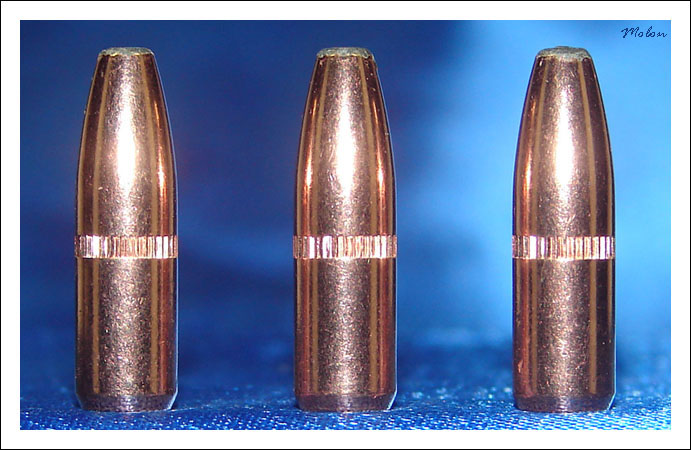

Winchester’s RA556B ammunition is loaded in WCC 5.56mm brass that has the annealing iris still visible. The primers are crimped and sealed. The case mouth has a heavy collet crimp and “black Lucas” sealant. The cartridge is charged with “ball” powder.
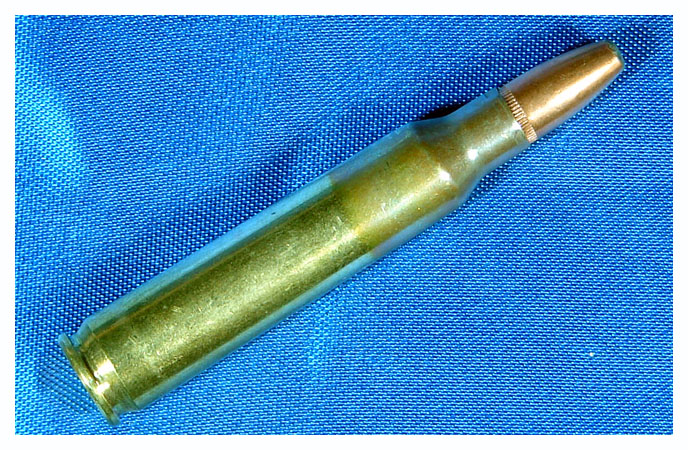
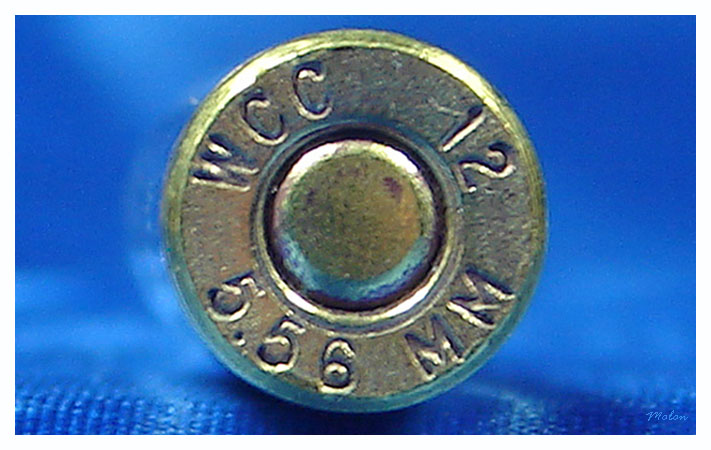
A ballistic table on the back of the RA556B ammunition box claims that this load has a muzzle velocity of 2935 FPS, but unfortunately there is no mention of the barrel length used for this figure. The standard barrel length for assessing the velocity of 5.56mm ammunition is a 20” barrel. A review of Winchester’s law enforcement ammunition literature revealed that the above velocity figure was indeed derived from a 20” barrel with a NATO chamber and a 1:7” twist.

I chronographed the Winchester Ranger 5.56mm 64 grain RA556B ammunition from a semi-automatic AR-15 with a chrome-lined, NATO chambered 20” Colt M16A2 barrel with a 1:7” twist

Chronographing was conducted using an Oehler 35-P chronograph with “proof screen” technology. The Oehler 35P chronograph is actually two chronographs in one package that takes two separate chronograph readings for each shot and then has its onboard computer analyze the data to determine if there is any statistically significant difference between the two readings. If there is a statistically significant difference in the readings, the chronograph “flags” the shot to let you know that the data is invalid. There was no invalid data flagged during this testing.
The velocity stated below is the muzzle velocity as calculated from the instrumental velocity using Oehler’s Ballistic Explorer software program. The string of fire consisted of 10 rounds over the chronograph.
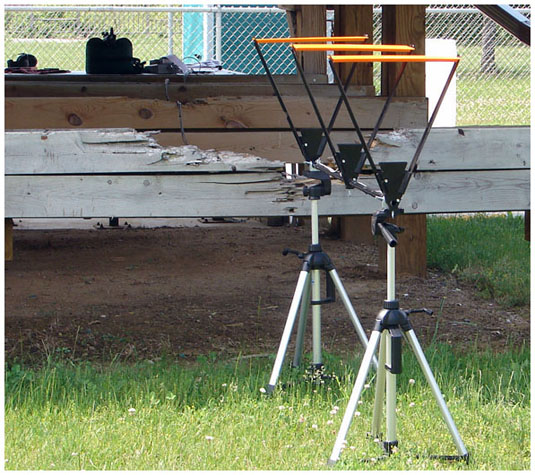

Each round was single-loaded and cycled into the chamber from a magazine fitted with a single-load follower. The bolt locked-back after each shot allowing the chamber to cool in between each shot. This technique was used to mitigate the possible influence of “chamber-soak” on velocity data. Each new shot was fired in a consistent manner after hitting the bolt release. Atmospheric conditions were monitored and recorded using a Kestrel 4000 Pocket Weather Tracker.

Atmospheric conditions
The muzzle velocity for the 10-shot string of the Winchester RA556B ammunition fired from the 20” Colt barrel was 2976 FPS with a standard deviation of 20 FPS and a coefficient of variation of 0.67%.
For those of you who might not be familiar with the coefficient of variation (CV), it is the standard deviation, divided by the mean (average) muzzle velocity and then multiplied by 100 and expressed as a percentage. It allows for the comparison of the uniformity of velocity between loads in different velocity spectrums; e.g. 77 grain loads running around 2,650 fps compared to 55 grain loads running around 3,250 fps.
For comparison, the mil-spec for M193 allows for a coefficient of variation of approximately 1.2%, while one of my best 77 grain OTM hand-loads, with a muzzle velocity of 2639 PFS and a standard deviation of 4 FPS, has a coefficient of variation of 0.15%.
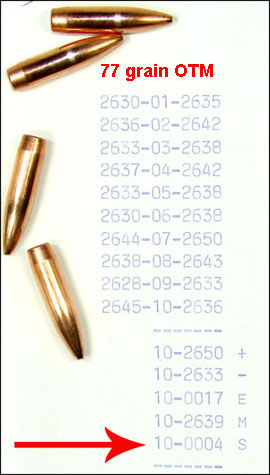
I conducted an accuracy (technically, precision) evaluation of the Winchester Ranger 5.56mm 64 grain RA556B ammunition following my usual protocol. This accuracy evaluation used statistically significant shot-group sizes and every single shot in a fired group was included in the measurements. There was absolutely no use of any group-reduction techniques (e.g. fliers, target movement, Butterfly Shots).
The shooting set-up will be described in detail below. As many of the significant variables as was practicable were controlled for. Also, a control group was fired from the test-rifle used in the evaluation using match-grade, hand-loaded ammunition; in order to demonstrate the capability of the barrel. Pictures of shot-groups are posted for documentation.
All shooting was conducted from a concrete bench-rest from a distance of 100 yards (confirmed with a laser rangefinder.) The barrel used in the evaluation was free-floated. The free-float handguards of the rifle rested in a Sinclair Windage Benchrest, while the stock of the rifle rested in a Protektor bunny-ear rear bag. Sighting was accomplished via a Leupold VARI-X III set at 25X magnification and adjusted to be parallax-free at 100 yards. A mirage shade was attached to the objective-bell of the scope. Wind conditions on the shooting range were continuously monitored using a Wind Probe. The set-up was very similar to that pictured below.
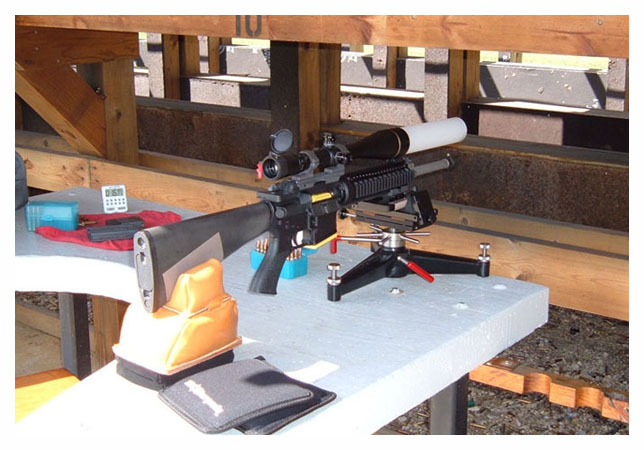
The Wind Probe.

The test vehicle for this evaluation was one of my semi-automatic precision AR-15s with a 20” stainless-steel Lothar Walther barrel. The barrel has a 223 Wylde chamber with a 1:8” twist. Prior to firing the Winchester RA556B ammunition, I fired a 10-shot control group using match-grade hand-loads topped with the Sierra 55 grain BlitzKing. That group had an extreme spread of 0.635”.

Next, three 10-shot groups of the Winchester RA556B load were fired in a row with the resulting extreme spreads:
for a 10-shot group average extreme spread of 1.90”. The three 10-shot groups were over-layed on each other using RSI Shooting Lab to form a 30-shot composite group. The mean radius for the 30-shot composite group was 0.66”.
The smallest 10-shot group . . .

The 30-shot composite group . . .
